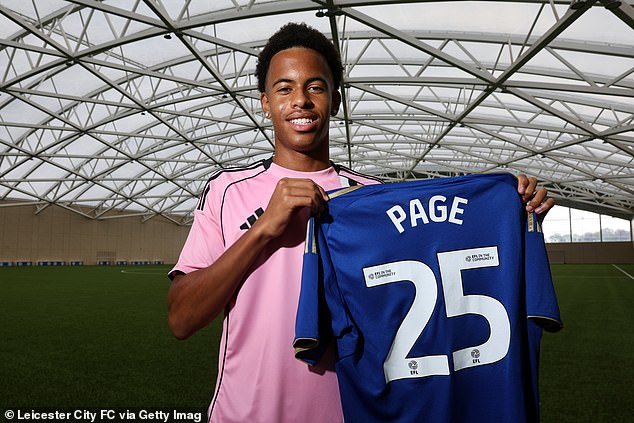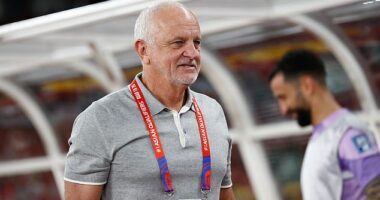It has been difficult to find much that is positive to say about Leicester City in recent times.
The club who delighted supporters across the globe when they lifted the Premier League title in 2016 have been in a sad state for much of the last 12 months.
There has been a second relegation in two seasons, financial issues that may bring a points deduction, two managerial sackings and a fanbase that turned decisively against the team and the owners. Nearly a decade on from the greatest day in their history, life at Leicester felt bleak and it was unclear when it would become better.
Though the road ahead is difficult, the 2-0 win over Birmingham on August 29 perhaps marked the first steps towards revival. Leicester’s first goal, a glorious strike by Abdul Fatawu, was teed up by 17-year-old Louis Page. Ricardo Pereira’s clincher was set up brilliantly by Jeremy Monga, who turned 16 only in July.
Monga and Page are two of the jewels of the Foxes’ academy, which Leicester hope will solve the problems of today and tomorrow.
Daily Mail Sport has investigated how Leicester are starting to rebuild from the ground up.

The Seagrave training centre, complete with The Dome, a huge indoor space with an artificial pitch, has helped convince wonderkids such as Louis Page to stay at the club

Seagrave was also a factor in keeping the highly talented winger Jeremy Monga, 16, at the club

There is a special gym at Seagrave dedicated to the physical development of youth players
Seagrave training ground – a curse and a blessing
When Leicester were relegated from the Premier League in 2023 with a team featuring Jamie Vardy, Youri Tielemans, James Maddison and Harvey Barnes, their £95million Seagrave HQ was used as a stick to beat them.
The facilities at the 185-acre site are some of the best in Europe but they seemed to contribute to a sense of complacency and entitlement among the first-team players, particularly in that 2022-23 campaign.
Initially, some staff struggled to settle at the new base, near Sileby in rural Leicestershire. It lacked the intimacy of their old home at Belvoir Drive, closer to the city centre, and it seemed Leicester had spent nearly £100m only to become worse off. Relegations in 2023 and 2025 appeared to confirm it.
Though the club are back in the Championship, we are seeing the benefits of Seagrave now.
The 21 pitches, 14 of which are full-size, mean the club’s junior sides can be prioritised, unlike at other clubs where academy players see their sessions delayed or cut short when others overrun. The quality of the surfaces is also far better than at many of Leicester’s peers and there is a special gym dedicated to the physical development of youth players.

Leicester City’s 185-acre Seagrave Training Ground cost £95m – it has 21 pitches, 14 of which are full-size, and means the club’s junior sides can be prioritised

Jake Evans is put through his paces in pre-season at Seagrave, where the facilities are among the best in Europe

When Leicester were relegated from the Premier League in 2023, their HQ was used as a stick to beat them
The recovery facilities, including hydrotherapy pools, are available to all players, not just the senior squad. Before Leicester’s Under 16 and Under 17 teams travelled to Florida last season for a tournament, they used the training ground’s heat chamber to prepare for the conditions in the United States.
It is not solely about football, either. For youth players, Wednesdays are devoted to education, as are Monday mornings and Friday afternoons. Leicester offer A-level, BTEC and Level 2 (similar to GCSEs) courses, delivered by in-house teachers.
The club also has a partnership with Ratcliffe College, a nearby private school charging up to £25,000 per year, and the timetable can be adapted for players like Page or Monga who are promoted to train with senior sides.
The contact time Leicester have with their Under-18 players runs across six days. Typically, players will arrive at 8.45am for breakfast. Before the morning training session, there is gym work and a technical and tactical briefing.
After lunch in Leicester’s sumptuous canteen, where players can follow their own nutrition plans, afternoons are spent on individual development – physical, tactical, technical, or educational. Players leave Seagrave at 5pm.
The Monga love bomb plan
A training ground alone cannot ensure Leicester keep their best players, but it was certainly a factor in hanging on to Monga, their gifted teenage attacker.
Deservedly lambasted for numerous howlers in recent seasons, Leicester have had little praise for keeping Monga, who made his Premier League debut for the club last season aged 15 years and 271 days against Newcastle in April. It was, however, one of the transfer coups of the summer.
Nobody believed Leicester could do it. In similar cases, there have been tales of financial inducements offered by elite clubs to young players, such as mortgage settlements, one-off payments, cars or properties. Under such circumstances, it is nearly impossible for smaller clubs to compete.

It was a coup for Leicester to keep Monga, amid interest from Manchester City and Chelsea

Former manager Ruud van Nistelrooy was crucial in keeping Monga at the club
While there is no suggestion any club offered terms like these to Monga or his family, he was certainly strongly admired by Manchester City and Chelsea. Many other clubs, including Paris Saint-Germain and Real Madrid, had watched Monga, now 16, and liked what they had seen.
Yet Leicester spent months working on a proposal that ensured Monga, who is from Coventry but has been with the Foxes since he was eight, stayed where he is.
Former boss Ruud van Nistelrooy and existing coaching staff held several meetings with the player and his family. They explained how Monga would be involved regularly with the first team and if he maintained his progress, would eventually become one of its stars. Better to play regular senior football for Leicester than be lost in the youth system of a Premier League title challenger, as has happened to countless prospects.
Bill Wall, Leicester’s acclaimed head academy scout, was also involved in the process, along with the academy coaches who have guided Monga through every stage. By maintaining links between Wall and the players he discovered, Leicester help their youngsters develop an affinity with the club and their surroundings.
Leicester had another ace up their sleeve, too. When trying to sign a top young player from an EFL club, Premier League sides will often use their superior facilities to persuade them.
That was not possible with Monga, who knew he had the perfect environment in which to fulfil his potential. That £95m is starting to look a good investment.
The keep-them-local ethos
Unlike many academies, Leicester rarely recruit Under-16 players from different parts of the country. Not only do such deals require compensation, Leicester feel they might dilute the strong local feel they have sought to create within the academy.
Of the nine academy players in the squad for Leicester’s Carabao Cup match at Huddersfield in August, all but goalkeeper Jakub Stolarczyk and defender Bade Aluko have been with the club since Under 9s level.

Will Alves is one of a huge crop of Leicester-born players who can star for the club in years to come after coming through the academy and Ratcliffe College
Four of them – Will Alves, Hamza Choudhury, Luke Thomas and Page – are from the Leicester area. Because of their relationship with Ratcliffe College, Leicester would be permitted to recruit Under 15s and Under 16s players from across the United Kingdom, but they have generally chosen not to.
Eleven players recently signed their first professional deals with the club and many were from Leicester or nearby.
Leicester hope their successors will continue to feel the benefit of Seagrave. As well as the features outlined already, ‘cage’ style pitches add variety and improve technique.
‘The Dome’ – a huge indoor space with an artificial pitch – means children can always train during the winter or in poor weather.
In the age of domestic and European spending rules, Leicester know that selling players is the route to financial health.
Academy products Ben Chilwell, Harvey Barnes, Kiernan Dewsbury-Hall, Kasey McAteer and Jeff Schlupp have brought in nearly £140m combined. There will surely be many more to follow them.
Cifuentes’ challenge
Leicester hired Marti Cifuentes as manager partly because of his experience with youth players and his commitment to promoting them. The Spaniard, who joined from Queens Park Rangers, was hugely impressed by Seagrave and excited at how he can turn it to his advantage.
Here is the rub, though. In the Championship this season, the Foxes’ starting XI has an average age of just above 26. Of the current or recent academy players, only Monga, Page and McAteer have featured. McAteer registered only 16 minutes before joining Ipswich for £12.1m, while Monga has played for 198 minutes and Page for 115.

Leicester hired Marti Cifuentes as manager partly because of his experience with youth players and his commitment to promoting them
Highly-rated defender Ben Nelson has been used only in the Carabao Cup. Aluko was an 89th-minute substitute in the 2-0 defeat at Bournemouth last season but has yet to play this term. Alves is on loan in League One with Huddersfield.
Some supporters have been frustrated to see Cifuentes stick with players like Wout Faes, Jannik Vestergaard, Harry Winks and Jordan Ayew, ageing players who were relegated from the Premier League.
Cifuentes would argue that, with the club in a tricky financial position and facing a points deduction, his priority must be to win promotion. If he can do it by backing home-grown players, so much the better.
After all, it is hard to imagine a better place for them to be.









